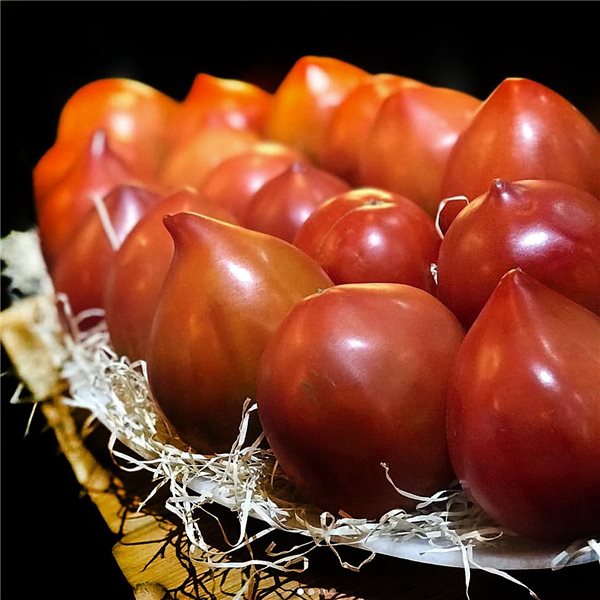
- Readers Rating
- No Rating Yet!
- Your Rating
The oxheart tomato, renowned for its distinctive shape and generous size, is a tomato variety of European origin that stands out for its sweet taste and fleshy texture. Its juicy and soft flesh, together with its robust and slightly acidic flavour profile, make it a highly sought-after ingredient. In this article we explain what differentiates this type of tomato from the rest, from Mikel, the current head of La vega y el Hortelano.
The tomato is an undisputed protagonist in the kitchen, but within the wide range of tomato varieties, the beefsteak tomato stands out as a culinary jewel with a unique taste and personality. This fruit not only enchants lovers of good food, but has also become a world-renowned culinary treasure. In this article, we will take a deep dive into the world of the beefsteak tomato, from its history and origin to its exceptional characteristics and how it can be enjoyed in a wide range of dishes. Get ready to explore the wonderful world of one of the most delicious and appreciated tomatoes, as we discover the interesting facet of its cultivation, which can be a challenge for those who wish to enjoy this exquisite fruit at its best.
Origin of the oxheart tomato
The oxheart tomato has a history that is interwoven with the mysteries of the past. Although its origins are not entirely clear, it is believed to originate from the regions of Eastern Europe and Siberia, where it has been cultivated for centuries. Over time, it has travelled to different countries and has steadily gained popularity. In this segment, we will explore the fascinating history of this tomato, from its discovery to its eventual arrival on international markets, where it has conquered the most demanding palates.
Buy beef heart tomato at La Vega y el Hortelano

Characteristics
The oxheart tomato is distinguished by its unmistakable appearance and exceptional characteristics:
- Shape and Size: This tomato resembles a heart, which earned it its peculiar name. It can reach a considerable size, weighing up to a pound or more.
- Colour: The colour ranges from soft pink to deep red, and the skin usually has a pattern of smooth stripes or wrinkles.
- Texture: The flesh of this tomato is fleshy, juicy and contains few seeds, making it an ideal ingredient for a variety of culinary preparations.
- Flavour: The flavour is one of the most outstanding aspects of the Beefheart tomato. Its sweetness, mildness and balanced acidity make it a delight to eat raw or cooked, while its fruity notes make it unmistakable.
Oxheart Tomato Varieties
The oxheart tomato is not a monotonous variety. On the contrary, there are several sub-varieties that offer slight differences in taste and appearance. Some of the most popular varieties include “Oxheart Pink”, “Oxheart Yellow” and “Oxheart Purple”. Explore these variants and discover how each has its own unique charm.
Cultivation
Growing the Oxheart tomato can be challenging, but the rewards are priceless. For those wishing to grow this exceptional fruit in their garden, it is crucial to know the growing guidelines. This includes information on the right soil type, irrigation needs, the importance of pruning and the challenges associated with pests and diseases. Learning the secrets to successful cultivation of this tomato will allow you to fully enjoy its unique flavour and texture.
Culinary uses of the oxheart tomato
The oxheart tomato stands out for its versatility in the kitchen. It can be used in a variety of ways, from fresh salads to pasta sauces and roasted dishes. Explore how to incorporate this tomato into your cooking and discover delicious recipes that bring out its unique flavour. From a simple beef heart bruschetta to a sophisticated ratatouille, this tomato takes every dish to the next level.
Nutritional and health benefits
Oxheart tomatoes not only delight the palate, but also offer significant nutritional benefits. It is packed with essential nutrients such as vitamin C, vitamin K and lycopene, a powerful antioxidant. Discover how incorporating this tomato into your diet can contribute to healthy eating and support your heart health.
Watch video explanation La Vega y el Hortelano
The oxheart tomato in global gastronomy
This tomato has found its place in the gastronomy of many cultures around the world. From Italy to the United States, it has become a prized ingredient in a variety of traditional and modern dishes. Explore how it is used in different cuisines and discover how chefs and cooks around the world appreciate its flavour and adapt their recipes to highlight its uniqueness.
Growing challenge: Why is this tomato difficult to grow?
The Oxheart tomato, despite its exceptional qualities, can be a challenge for growers and gardeners. There are several reasons for this:
- Size and Weight: Its considerable size and weight may require adequate support to prevent branches from bending or breaking under the weight of the ripe fruit.
- Water Requirements: Oxheart tomatoes are known for their need for constant water. Irregular watering can cause problems such as fruit cracking.
- Thorough Care: They require thorough care, including pruning and leaf removal to ensure good air circulation and prevent disease.
- Disease Susceptibility: They are susceptible to common tomato diseases such as powdery mildew and late blight, making pest and disease control essential.
Conclusion
The beefsteak tomato is a culinary treasure that has captured hearts and palates around the world. Its intriguing history, distinctive flavour and versatility in the kitchen make it an exceptional fruit. Whether you enjoy it in a simple summer salad or in an elaborate tomato sauce, this tomato offers a unique culinary experience. Let’s celebrate this gift of nature and continue to explore the endless possibilities of its flavour and versatility in the kitchen. This tomato is not only a culinary treasure, but also a challenge that rewards those who are willing to grow it with the care and attention it deserves. May the Beefheart tomato continue to inspire and delight food lovers around the world!
If you want to learn a little more about food, don’t miss our articles related to types of food.
